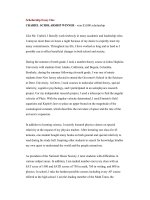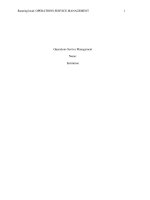star wars essay
Bạn đang xem bản rút gọn của tài liệu. Xem và tải ngay bản đầy đủ của tài liệu tại đây (26.92 KB, 2 trang )
Star Wars: An Intergalactic Joyride
"Star Wars" is the highest grossing movie of all time. It
is also one of
my favorites. It was released in May 1977 and re-released in a
restored and
enhanced Special Edition just last month. There are many
different criteria that
can be used to describe ŒStar Wars' appeal. Gary Arnold and
Edward Rothstein,
two movie critics who had the opportunity to review this great
movie, explain
its appeal in very much the same way. There is a difference
though. Arnold
reviewed the original ŒStar Wars' twenty years ago and Rothstein
reviewed the
recent Special Edition. While they reviewed slightly different
versions, they
both came to the conclusion that Star Wars is a great movie based
on similar
criteria. They judged ŒStar Wars' on its ability to draw on
classic styles and
timeless stories to create something new and absolutely original.
The main factor in both of their positive reviews is the
skill of writer
and director George Lucas to blend the old with the new. They
were both
impressed with his miraculously fresh configuration of many
different themes
from classic film and mythic origin into a cohesive and
entertaining movie. He
has achieved a witty and exhilarating synthesis of themes and
cliches from the
Flash Gordon and Buck Rogers comics and serials, plus such
related but less
expected sources as the western, the pirate melodrama, the aerial
combat
melodrama and the samurai epic. The movie's irresistible
stylistic charm
derives from the fact that Lucas can draw upon a variety of
action-movie
sources with unfailing deftness and humor. He is in superlative
command of his
own movie-nurtured fantasy life. Gary Arnold, Washington Post
Staff Writer
Mr. Rothstein along the same lines as Mr. Arnold, mentions that
Œthe plot line
of Star Wars follows the mythic archetechture outlined by Joseph
Campbell in his
study of myth, "The Hero with a Thousand Faces," which has
influenced Mr.
Lucas.'
Another aspect, unique to Rothstein's review of the new
Special Edition but
not quite different from Arnold's assessment, is the way in which
the movie
celebrates the past and not the future. This aspect of ŒStar
Wars', Rothstein
says, is what Œscreams out in opposition to the high-budget,
high-tech, special-
effect spectaculars that it (Star Wars) spawned.' This is where,
Rothstein says,
that ŒStar Wars' gets its authenticity. The whimsical
ramshackleness is actually
meant to be a sign of the heroes' authenticity: what is older is
more powerful
technology, when it appears in ŒStar Wars,' is evil, ghastly,
massive and
brutish "advanced" invention is most evident in the space ships
of the evil
Empire. Edward Rothstein, Movie Critic, New York Times
This "ramshakleness" that Rothstein speaks of keeps the
movie afloat by not
sacrificing the story for special effects. The special effects
complement the
movie, but do not carry it. This is where Rothstein says that so
many recent
movies have failed. Arnold, unable to see into the future, was
unable to
evaluate the movie in this way. He hadn't the chance to see how
badly Hollywood
would try to imitate ŒStar Wars', thinking its appeal lay more in
its Œeffects
and quick jolts, rather than from the mythic significance with
which they were
injected.'
Hollywood never grasped fully the lesson taught by ŒStar
Wars'. Both
Rothstein and Arnold believe that this lesson is what makes ŒStar
Wars' so great.
They used the same criteria (the convincing story, admirable
characters, and
the writer/director Lucas's skill as a storyteller) to come to a
positive review
of the movie. Arnold summed it up in his closing "Lucas' use of
old time
conventions and stories add to the movie in such a way as to
create the unique
and fresh fantasy world that is ŒStar Wars'."
Works Cited:
Arnold, Gary. "Star Wars: A Spectacular Intergalactic Joyride."
The Washington Post. 25 May 1977.
Rothstein, Edward. "'Star Wars' Salutes a Brave Old World."
The New York Times. 31 January 1997.









